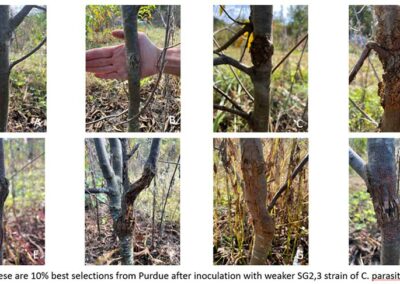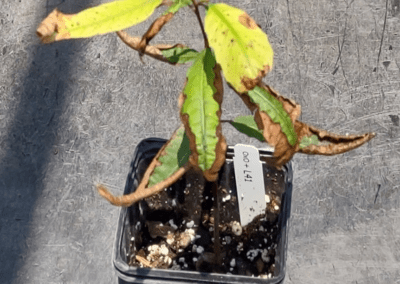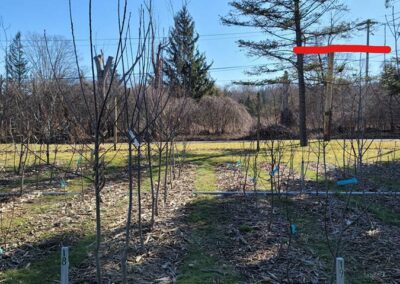Darling 58 /54
Darling 54 FAQ
In December 2023, The American Chestnut Foundation (TACF) withdrew its support for SUNY-ESF’s Darling transgenic chestnut project. Since then, we’ve received questions about the decision and what’s next for the Darling line. We appreciate those questions because they indicate a deep interest in our mission and reflect the spirit of scientific curiosity and rigor, which are central to who we are. We have developed FAQs to provide clarity and answer lingering questions.
What is the Darling project?
Darling 58 (D58) is an American chestnut that has been genetically modified via the insertion of a gene (OxO) from wheat into the tree’s genome. The oxalate oxidase (OxO) gene degrades oxalic acid, a toxin produced by the chestnut blight fungus (Cryphonectria parasitica) as an important weapon in its attack on chestnut trees. D58 was developed by scientists at the American Chestnut Research and Restoration Project (ACRRP) at SUNY-ESF in Syracuse, NY.
ACCRP began their transgenic research on American chestnuts in the early 1990s with personal philanthropic support from former TACF board chair Herb Darling, and this work became the focus of TACF’s New York Chapter. After the D58 tree was created and showed promise of superior blight resistance in greenhouse experiments, TACF’s board of directors made the decision to support and prioritize the work of ACRRP and the New York Chapter. D58 specifically, and transgenic research broadly, was a complement to the breeding programs of TACF in which we had been engaged since 1983.
Over the past 11 years, TACF has provided more than $2 million in funding to the ACRRP for their work on transgenic American chestnuts. Additional assistance, also valued at approximately $2 million, in the form of expert legal counsel, experimental design and testing, and general outreach, have provided crucial support and guidance to ACRRP in its applications to deregulate D58.
Why did TACF withdraw support from the Darling project?
In 2023, TACF decided to withdraw support of the D58 transgenic chestnut petitions after a thorough review of the facts, based primarily on these factors:
- D58 Performance: Observational data on transgenic trees thought to be D58 from multiple orchard locations indicated a number of corroborating deficiencies and concerns, including inconsistent blight resistance, a negative impact on growth, and decreased survival rates. See Darling 58 Performance page.
- Mislabeling of the D54/D58 product: In late 2023, TACF learned of a lab error at SUNY-ESF that resulted in mislabeling and confusion between two distinct transgenic trees, D54 and D58. The error may have occurred as early as 2016, but regrettably was not discovered or reported to TACF until 2023. The mislabeling meant the regulatory petitions were filed as D58 when they should have been identified as D54. Unfortunately, this unintentional lab error concealed changes to coding regions of the genome with unknown and untested effects on growth and survival.
- Potential Regulatory Issues: Based on the advice of our regulatory counsel in Washington, DC, TACF concluded that the mislabeled product raised additional questions about the data submitted and TACF could not support SUNY-ESF’s submission if they proceeded. Factual errors in any petition may adversely impact credibility, call into question the accuracy of other data supplied by the applicant, and potentially fuel otherwise unfounded accusations by critics of genetic engineering (GE) that developers are not doing enough to ensure the safety of GE products.
- Commercialization of the D54/D58 transgenic chestnut: Finally, we were surprised and concerned when SUNY-ESF proposed the commercialization of the D54/D58 transgenic chestnut through an exclusive partnership with American Castanea Inc, a for-profit startup company. We believed then, and continue to believe today, that pricing seedlings to yield a commercial profit would jeopardize success and is inconsistent with our commitment to advance TACF’s mission as a 501(c)(3) nonprofit. Even after sharing these profound concerns about entering into a SUNY-ESF exclusive license with American Castanea Inc, SUNY-ESF offered a variety of high-cost proposals to TACF, all of which continued to demonstrate their interests in using D54, a transgenic tree TACF considers unsuitable for restoration, as a means to fund their programs. SUNY-ESF continued to request annual six-figure licensing fees and royalties, while requesting TACF’s continued financial support of SUNY-ESF research. We believe that payment of these fees would divert critical funds from our core research and the development of an effective restoration tree.
For all these carefully considered reasons, TACF decided that it could no longer support the D54/D58 petition. However, TACF does not oppose further research on D54 and D58, nor are we opposed to other applications of biotechnology to save the American chestnut or other tree species.
TACFs decision felt really abrupt. Was it?
Did plans to commercialize the Darling chestnut contribute to TACFs decision for withdrawal?
As reported in the Washington Post,[1] TACF was surprised to learn in mid-2022 that directors of the ACRRP had engaged with private investors who formed a company, American Castanea Inc, to commercialize production of the Darling tree (now known to be D54).
Commercializing the transgenic American chestnut tree is contrary to statements made in regulatory filings and assurances given in public statements and to academic partners. The considerable support TACF provided to help ACRRP negotiate the regulatory process was based upon the understanding that a deregulated tree would be in the public commons.
Most importantly for TACF, for-profit production of seedlings would significantly impede restoration of American chestnut – our very mission – because the profit premium placed upon the cost of seedlings would prohibitively increase the already high expense of planting trees.
However, at the time we withdrew our support for the D54 petition, we were still hopeful of reaching an agreement with SUNY-ESF that would allow us to produce and distribute seedings at cost for restoration purposes.
TACF is unequivocally committed to the goal of creating a blight-resistant tree that can be distributed inexpensively and in large numbers for forest plantings.
There are reports that ACRRP researchers are seeing no flaws in D54 trees in greenhouse and orchard settings. Why the difference from TACF's observations?
We cannot explain this. Growth retardation, health issues, and cankering of Darling trees continue to be observed and documented across multiple sites, including ACRRP’s own orchards and greenhouse. These issues are seen specifically in OxO-positive trees in comparison to their OxO-negative full siblings grown in the same environments. Possible differences caused by growing conditions or specific parentage cannot account for the stark contrast within full-sibling cohorts that vary only in the presence of the OxO gene.
Did Anti-GMO groups influence TACF to pull support of Darling lines so it could focus on backcross breeding?
No. TACF remains committed to funding, creating, evaluating, and integrating modern, biotechnological techniques into the suite of methods that will ultimately lead to restoration of the American chestnut. Learn more about these efforts here (Strategic Science Plan) and here (Chestnut Chat).
Can additional breeding make D54 appropriate for restoration?
We do not believe that additional breeding to “fix” D54 is a viable path forward, especially compared to available alternatives. Continued work with D54 introduces technical problems (e.g., the damaged SAL1 gene) that would be extremely difficult or impossible to overcome. TACF would not have withdrawn our support if we believed otherwise.
What is the concern with releasing D54 into the landscape or using them in restoration projects?
TACF withdrew its support for D54 primarily because of severe blight on some trees derived from D54 and carrying the OxO gene, high mortality in trees homozygous for OxO, loss of function of the SAL1 gene, and other performance issues.
The body of available evidence strongly indicates that D54 is not a suitable platform with which to create a breeding population of trees for restoration.
Furthermore, even if some fraction of D54-derived trees could survive in forest plantings, we are concerned that overall poor performance would damage public confidence in biotechnology as a viable solution for some forest health problems.
Is TACF opposed to future collaborations with SUNY-ESF?
No. We collaborate with faculty and staff at many universities. SUNY-ESF’s ACRRP has pioneered important research toward the restoration of American chestnut, and we believe that they share our ambitious vision of an American chestnut restored to its former role within forest ecosystems of the eastern United States. TACF would welcome reengagement with SUNY-ESF in a productive and mutually beneficial relationship.
Rescue and Restoration of the American Chestnut
The American chestnut was an ecologically, economically, and culturally significant tree species in the Eastern United States. In the late 1800s, the introduction of the chestnut blight fungus (Cryphonectria parasitica) from Asia decimated an estimated four billion American chestnuts. Today, this iconic species rarely reproduces in the wild and is therefore considered functionally extinct.
The American Chestnut Foundation (TACF) is leading an unprecedented mission to restore the American chestnut tree to its native range. By employing complementary methods of traditional breeding, biotechnology, and biocontrol, TACF is working to create a disease-resistant and genetically diverse population of American chestnuts.
One of TACF’s greatest achievements is the establishment of a genetically diverse, reproducing population of thousands of American chestnut trees representing hundreds of breeding lines. These trees are planted in TACF’s expansive network of germplasm conservation orchards and regional breeding and backcross orchards. We have substantially increased blight-resistance and Phytophthora resistance in these populations. The future inclusion of transgenic and/or gene-edited trees will further increase those gains.
Restoration is an incremental process which will require the integration of multiple technologies and institutions. TACF is privileged to work with a diverse range of partners, from private landowners to university research labs, who inform the direction of our scientific inquiry. This collaboration allows TACF to compare results from across the native range of the American chestnut. Through this extensive research network, transgenic methods have shown great promise for generating a blight-tolerant American chestnut tree and play an important role in TACF’s science strategy and restoration efforts.
History of the Transgenic Darling 58 American Chestnut Tree
In 2015, The American Chestnut Research and Restoration Project (TACRRP) at the State University of New York College of Environmental Science and Forestry (SUNY-ESF) created the first line of transgenic American chestnut trees and named it after an early supporter of the project, Herb Darling. Deeming it a promising path toward American chestnut restoration, TACF began formally supporting TACRRP’s work in 2015 through significant funding and research support.
The goal of the Darling line of trees was to confer blight tolerance by inserting a gene from wheat called oxalate oxidase (OxO). The OxO gene detoxifies oxalic acid produced by the chestnut blight fungus and could hypothetically prevent lethal cankers on the tree. Many “events” (random insertions of the gene into the American chestnut genome) were created using the 35s constitutive promoter which causes the OxO gene to always be “switched on” in the tree’s tissues. These different events were given names such as Darling 4, Darling 54, and Darling 58, and were tested for gene placement and OxO expression. One, named Darling 58, was selected for further lab and field testing.
Initial laboratory and greenhouse tests on Darling 58 trees (also known as D58) showed that high disease-tolerance was being conferred by the OxO gene. Extensive safety tests showed no significant difference in the Darling chestnut’s interactions with other organisms compared to American chestnut (read about Nutrition, Wildlife, Plants & Fungi), and the Darling 58 product was poised to play a significant role in American chestnut restoration.
As a result, TACRRP submitted petitions for deregulation to USDA APHIS, EPA, and FDA with the goal that the Darling tree could eventually be used in the wild to restore American chestnut populations. Based on these results and its ongoing support for biotech research, TACF extensively supported TACRRP throughout the research efforts as well as the petitions for deregulation.
Discovery That Darling 58 Was Actually Darling 54
In late October 2023, partners at the University of New England and University of Maine informed TACF that there appeared to be a possible mix-up of pollen early in the D58 breeding program and shared with us their results.
In November 2023, TACF independently verified that information, confirming that the OxO gene of all trees thought to be Darling 58 was on a different chromosome than expected (chromosome 4 instead of chromosome 7). We have subsequently confirmed that all the trees we and other partners have been researching since 2016 are in fact descendants of a different event in the Darling line called Darling 54 (D54).
Why TACF Withdrew Support for the Darling Line
Throughout 2023, TACF and its partners observed disappointing performance results from broad-scale field and greenhouse tests of advanced generations of Darling trees across several geographic locations. As discussed in the September 15, 2023 episode of TACF’s Chestnut Chat webinar series (Darling 58 Update), analysis indicated striking variability in Darling trees’ blight tolerance, significant losses in growth competitiveness, reduction in overall fitness including stunted growth, leaf browning and curling, and increased mortality. View an outline of the body of evidence concerning Darling’s performance issues on the Darling 58 Performance page.
In Darling 54, the OxO gene has been inserted into a coding region, causing a deletion of 1,069 base pairs in a salinity tolerance gene called SAL1. That research has also indicated that the homozygous state of Darling 54 (when an individual plant inherits a copy of the OxO gene from both parents, which occurs in 25% of offspring) is largely lethal, and that a great majority of homozygous offspring die in the embryonic stage.
The fact that the 35S OxO construct in D54 interrupts a known gene, and has caused a large deletion of that gene, combined with the disappointing performance of the D54 trees in the field and the observed lethal homozygosity, have led TACF to conclude that this product should not be distributed or propagated beyond permitted sites. TACF believes these genetic issues should not be proliferated into current or future restoration or commercial chestnut populations.
In addition to those baseline scientific concerns, TACF is also concerned that further production or development of D54 would decrease public acceptance of the use of biotechnology in forest health and restoration efforts. Knowingly producing and proliferating trees with genetic issues, especially after establishing that these were at least partially the result of an early error, is bound to erode public trust in both the process and the producers of such a product.
Why not then return to the “real” Darling 58? The first reason is that the Darling 58 also uses the 35S constitutive promoter which appears to result in a variety of metabolic costs to the tree and likely causes the majority of performance problems observed in the Darling line. Secondly, there are only a handful, and perhaps even only one, D58 tree(s) in existence. These trees are at either the T0 or T1 stage (the original event and first-generation offspring). If work is to start over at those early diversification stages, it makes sense to focus on new OxO lines that express the gene only in tissues infected with blight. Confining OxO expression to blight infected tissues should reduce the metabolic cost of expressing this gene, thus these new lines are more likely to have enhanced forest competitiveness.
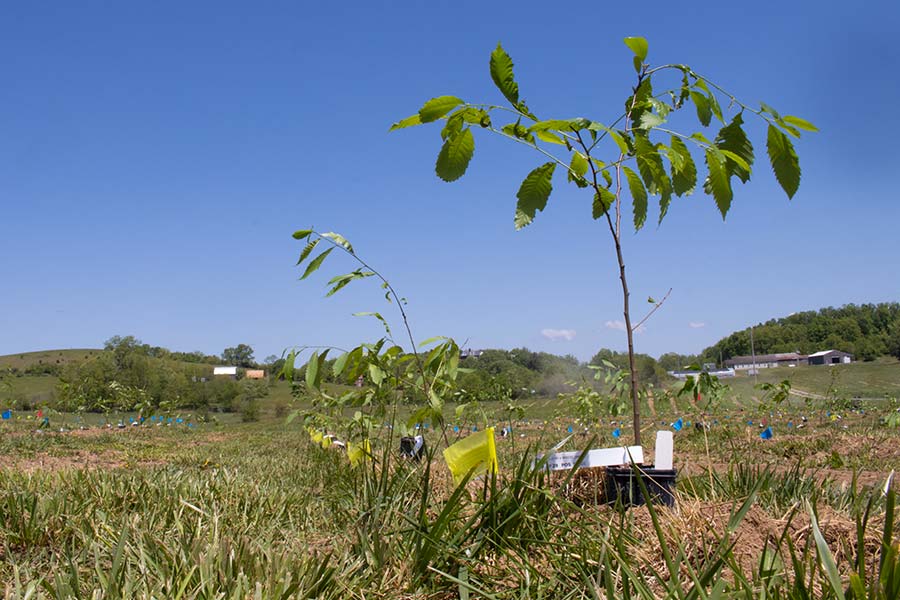
Watch a recording of the live December 15, 2023 Chestnut Chat about Darling 58/54 performance issues and TACF’s decision to discontinue developing the Darling line.
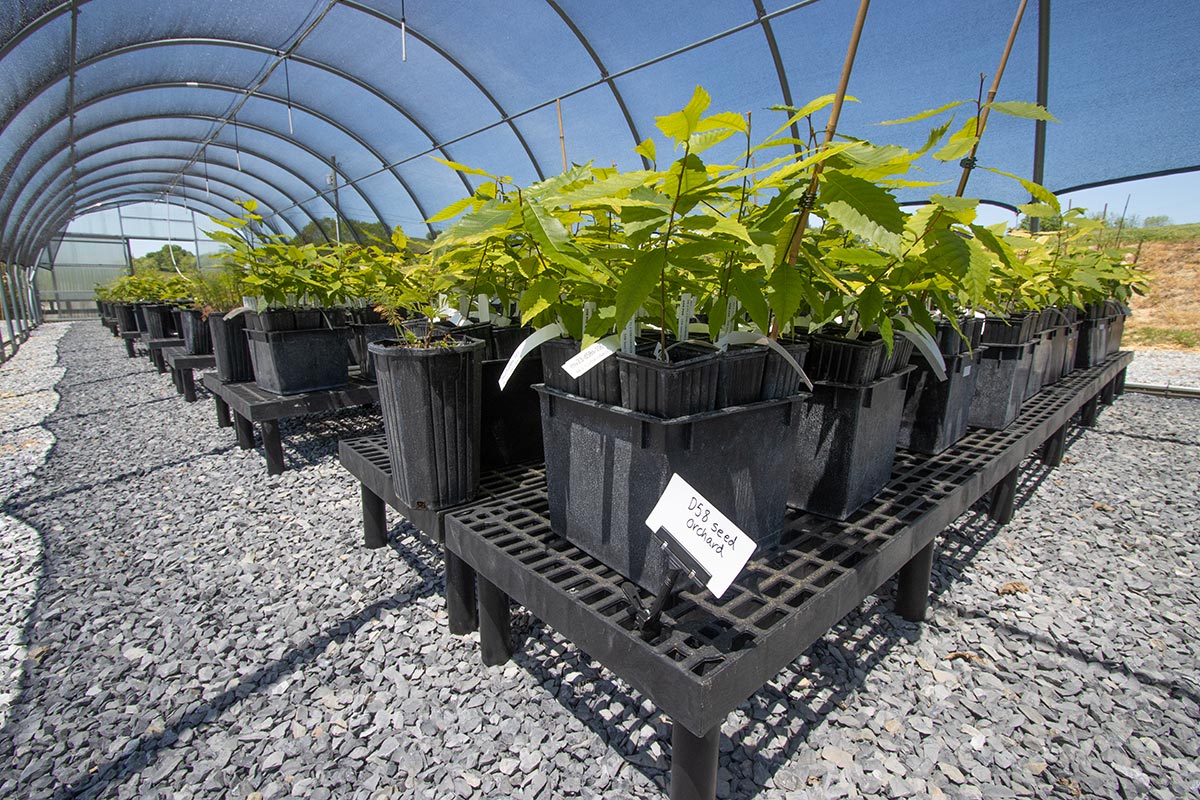
Watch a recording of the live September 15, 2023 Chestnut Chat webinar about Darling 58 regulatory updates and performance issues.
What’s Next?
The Darling transgenic line was one of many branches in TACF’s multi-pronged approach to American chestnut restoration. A diversified portfolio of research initiatives and an extensive partner network ensures that other disease-resistant prototypes, created from breeding and biotechnology methods already in the research pipeline, can be comprehensively vetted and released in a reasonable time frame. Learn more about these projects in the Current Initiatives section below.
We remain hopeful and optimistic that restoration of the American chestnut will be achieved thanks to continued support from your membership and donations and from our dedicated network of volunteers and research partners.
Guiding Principles for Science and Restoration Efforts:
Based on lessons learned through the process of researching and testing Darling lines of trees, TACF has created the following framework to better guide future efforts.
- Rigorous testing for efficacy throughout the life cycle of the tree life cycle (both in the lab and greenhouse, and in the field) prior to regulatory submission
- Rigorous testing for plant health and environmental risks
- Implementation of a tree improvement cooperative structure which can facilitate shared intellectual property, provide full transparency across all members, and ensure the rigor and comprehensiveness of scientific methodology and analysis
- Ensuring products remain in the genetic commons as much as is possible, while also protecting the quality and integrity of a given product (for example, through material transfer agreements)
Current Research Initiatives
Traditional Breeding with Advanced Genomic Selection
TACF continues to make gains in blight resistance with its traditional American chestnut hybrid breeding program by selecting backcross hybrid parents that combine high American chestnut ancestry with above-average blight resistance and then breeding these superior parents together. TACF is working with partners to develop a rapid genotyping method that will allow researchers to more efficiently predict blight resistance and select offspring that have better blight resistance than their parents.
TACF is also investigating whether blight resistance traits of wild, large surviving American (LSA) chestnut trees can be passed to offspring and combined with other methods of increasing resistance.
Inducible OxO Transgenic Lines
Insertion of the OxO gene still holds promise as a method to increase blight tolerance in American chestnut. Expressing this gene with inducible promoters, that confine expression to only blight infected tissue, has the potential to reduce the growth and survival penalties observed with constitutive promoters. ESF researchers have developed a prototype inducible OxO line that expresses the gene only in tissues that are wounded or blight infected. In addition, our collaborators at the University of Georgia are developing founders with a blight inducible OxO gene using a variety of inducible promoters to fine tune the expression of OxO. In the next few years, we will be conducting field trials and laboratory experiments to assess the performance of these inducible OxO lines.
Stacking Inducible OxO With Backcross Hybrids
TACF is also conducting experiments to combine inducible OxO expression with additional genes for blight resistance through breeding. For several years, TACF has been breeding OxO transgenic trees with American chestnut backcross hybrids and with large surviving American chestnut parents selected for increased blight resistance. Results obtained in the coming years will show whether or not there is an additive effect of stacking OxO with resistance genes from chestnut.
Inserting Resistance Genes From Other Chestnut Species
If it is determined that resistance in Chinese chestnut is additive with OxO, another potential pathway is to insert genes from Chinese chestnut directly into American chestnut using methods similar to OxO insertion. TACF has made substantial progress in identifying candidate genes from Chinese chestnut that may contribute to blight resistance. We are collaborating with researchers from Virginia Tech to validate whether these genes play a role in blight resistance.
Glossary
Expand the glossary below to see a list of terms and acronyms relating to Darling 58 research and deregulation.
Glossary of Darling 58-related Acronyms and Terms
APHIS – Animal and Plant Health Inspection Service – A unit of the U.S. Department of Agriculture responsible for protecting animal welfare, animal health, and plant health.
Backcross breeding – a technique to develop disease resistance wherein American and Chinese chestnuts are bred together and their progeny are bred with American chestnuts to produce a mostly American chestnut with traits of resistance
B3F3 (or similar conventions) – common nomenclature to refer to 7th generation backcrossed progeny of American and Chinese chestnuts by TACF
BRAG – Biotechnology Risk Assessment Grant – A funding program of the U.S. Department of Agriculture’s National Institute of Food and Agriculture intended to support generation of scientific evidence needed to assess affects of introduction of genetically engineered organisms
CRISPR – Clustered Regularly Interspaced Short Palindromic Repeats – a technique for gene editing and insertion
Cryphonectria parasitica – The scientific name of the fungus that causes chestnut blight
Common garden experiment – A type of experiment used to compare how organisms from geographically or environmentally distinct sources respond to living and growing in the same environment. This helps parse their apparent differences into those driven by genetics and those driven by their environment.
Constitutive promoter – A promoter is a DNA region that “switches on” a gene. Technically it initiates “transcription” which is the process of creating a complementary strand of RNA which then makes a protein (for example, the enzyme oxalate oxidase). A “constitutive” promoter is one that is always “switched on” meaning the gene is expressed at all times in all tissues.
D58 – Darling 58 – transgenic variety of American chestnut developed at SUNY-ESF
DarWin – Darling with Wound Inducible promoter. A transgenic chestnut tree which expresses the same OxO gene as D58, but only when wounded and only at the site of wounding, developed at the Powell lab at SUNY-ESF
Deregulation – the current process of submitting appeals to the USDA, EPA, and FDA to allow wider dispersal and expanded trials of the transgenic D58 chestnut tree
EPA – Environmental Protection Agency
FDA – Food and Drug Administration
FHI – Forest Health Initiative
GCO – Germplasm Conservation Orchard – an orchard where seeds from wild-type American chestnuts are planted to preserve their genetic diversity
Hypovirulence – a phenomenon wherein the blight fungus is weakened by infection with a virus. Depending on the interaction and relative virulence of the fungus and virus, the fungus may exhibit slower growth, reduced virulence and overall reduction in fitness.
MOU – Memorandum of Understanding – an agreement between TACF and a partner organization that documents the goals and general terms of that partnership
OxO – Oxalate oxidase – The terms commonly applied to a gene that produces the enzyme oxalate oxidase, which neutralizes oxalic acid. In American chestnut restoration context, the OxO gene is one of the most promising to confer resistance to the chestnut blight fungus.
PRR – Phytophthora root rot/ink disease
Phytophthora cinnamomi – the scientific name for the organism which causes Phytophthora root rot
Pure/purity – a commonly misconceived quality attributed to wild-type American chestnuts. All chestnut species have experienced hybridization events
Reciprocal transplant experiment – A set of replicated common garden experiments where organisms from all source populations are compared in each other’s and in their own habitats of origin. This helps uncover whether particular populations are well adapted only to their own habitats or in other habitats as well.
RNAi – In the context of American chestnut restoration, this is a method whereby partial sequences of important pathogenicity genes from the chestnut blight fungus are inserted into American chestnut. The partial fungal sequences are expressed in the chestnut tree as double-stranded RNA, which are then degraded by the chestnut trees through a pathway called RNA interference. The degradation of the key fungal pathogenicity genes by the host reduces the chestnut blight fungal virulence. Thus far ESF researchers have used this technology to silence chestnut blight genes involved in the production of oxalic acid, which reduces the chestnut blight fungus’s ability to kill tissues in chestnut bark.
ROC – Regional Outreach Coordinator – employee of TACF responsible for oversight of chapters and volunteer initiatives in their respective region
RSC – Regional Science Coordinator – employee of TACF responsible for oversight of scientific endeavors in their respective region
RSC – Resistance Screening Center – a US Forest Service facility at Bent Creek Experimental Forest, Asheville, NC
S&T – Science & Technology Committee of the Board of Directors of The American Chestnut Foundation.
SSA – Small stem assay. An inoculation trial performed on seedling trees wherein the pathogen is artificially administered in order to compare differences in apparent response for early screening of disease resistance.
Stacked resistance – a technique utilizing the best progeny of the backcross breeding program to then cross with transgenic American chestnut to yield offspring with resistance characteristics from both techniques
SUNY-ESF – State University of New York College of Environmental Science and Forestry
Transgenic – modification of an organism using an inserted gene that comes from a different organism that is not sexually-compatible with the target organism
TACF – The American Chestnut Foundation
USDA – United States Department of Agriculture
Wild-type American chestnut – a tree which is either a member of the remnant population of American chestnuts in the wild, or progeny thereof.
Darling 58 Resources
- Press Release: TACF Discontinues Development of Darling 58. December 8, 2023
- Darling 58 Performance: evidence of performance issues in Darling 58
- Safety Tests on Transgenic American Chestnut, Part 1: Nutrition
- Safety Tests on Transgenic American Chestnut, Part 2: Wildlife
- Safety Tests on Transgenic American Chestnut, Part 3: Plants & Fungi
